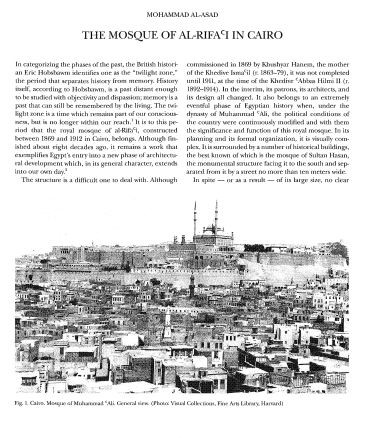
Al-Rifa’i Mosque, also known as Royal Mosque, is a mosque in Cairo, Egypt. It is located in the Islamic Cairo district, next to the Mosque of Sultan Hassan and a 16-minute walk to the Ibn Tulun Mosque. It was built between 1869 and 1912. Having initially been commissioned by Khedive Ismail Pasha, it was finally completed by Khedive Abbas II, under the supervision of the Hungarian architect Max Herz. It is considered to be a fine example of Islamic architecture in Cairo.
The al-Rifai Mosque is one of the largest mosques in Cairo and can accommodate up to 10,000 worshippers. The Mosque is built in the Ottoman style and is decorated with intricate marble work and stained glass windows. The Mosque also has several smaller domes and is illuminated by chandeliers.
Al‑Rifa’i Mosque’s architectural design is as interesting as its construction history. Visitors stand in awe of the detailed decoration of the outer walls and massive columns of the outer gate. The minarets are distinguished by their beauty and elegance. Among the remarkable pieces of furniture are an alabaster dikka (platform), supported by eight slender columns, an ornate wooden and alabaster minbar and several intricately designed chandeliers.
The original structure was a Fatimid mosque, which was then transformed into a shrine for Ali abu Sheibak. Finally, Ottoman queen Kosheir Hanim commissioned the current design of the mosque and put in charge of the construction the architect Hussein Pasha Fahmi. Part of the plan was to have a mausoleum for the royal family as part of the extension, which was made by imported building materials from Europe, such as Italian marble. In addition to traditional raw materials, cement has also been employed in the construction of the mosque—a first for any Islamic monument in Egypt—signalling the transition into modern times.
The building itself is a melange of styles taken primarily from the Mamluk period of Egyptian history, including its dome and minaret. The building contains a large prayer hall as well as the shrines of al-Rifa’i and two other local saints, Ali Abi-Shubbak and Yahya al-Ansari.
The mosque was the resting place of Khushyar Hanim and her son Isma’il Pasha, as well as other members of Egypt’s royal family, including Sultan Hussein Kamel, Sultan and King Fuad I, and King Farouk, whose body was interred here after his death in Rome in 1965. Khedive Tewfik and Khedive Abbas II Hilmi, however, are buried in Qubbat Afandina, a mausoleum built in 1894 in Cairo’s Eastern Cemetery, together with other late members of the Muhammad Ali Dynasty.
The mosque served briefly as the resting place of Reza Shah of Iran, who died in exile in the Union of South Africa in 1944, and was returned to Iran after World War II. He was buried in Cairo following the Iranian Revolution of 1979. Part of the burial chamber is currently occupied by Reza Shah’s son Mohammad Reza Pahlavi, who died in Cairo in July 1980.
The Mosque has several doors but the main entrance on the west side is under a dome decorated with gold. After the main entrance is the tombs of Abu Shebak and Ali Al-Ansari. The doors and windows are decorated with gold and wood ornaments. The walls are made of marble with colors from 7 different countries. The ceiling is high and cavernous. There are almost 44 pillars decorated with verses of the Golden Quran.
Disclaimer : Mopsqpedia is a non-profit database. All images featured in the database are sourced from various references, publications, and websites related to mosque architecture. Mosqpedia does not claim ownership of any images unless explicitly stated. Images are provided solely for educational and bibliographic purposes. Mosqpedia disclaims any responsibility for copyright infringements related to the images displayed. Users are responsible for verifying copyright status and obtaining permission from original sources if they intend to reproduce, distribute, or use any image beyond fair use.
I agree to the terms outlined below:
You agree to upload and assign Mosqpedia Database the rights to use the content worldwide and in perpetuity across all current and future media platforms. Mosqpedia Database may edit, copy, adapt and translate your contribution.
The content will be distributed under the Creative Commons Attribution-Deed – Attribution-NonCommercial-NoDerivatives 4.0 International – Creative Commons
All data will be stored in line with data protection regulations.
I agree to the terms outlined below:
You agree to upload and assign Mosqpedia Database the rights to use the content worldwide and in perpetuity across all current and future media platforms. Mosqpedia Database may edit, copy, adapt and translate your contribution.
The content will be distributed under the Creative Commons Attribution-Deed – Attribution-NonCommercial-NoDerivatives 4.0 International – Creative Commons
All data will be stored in line with data protection regulations.